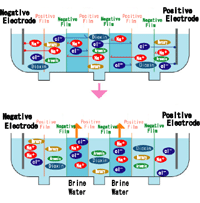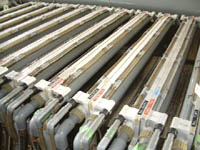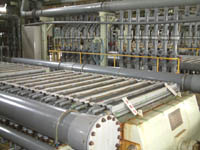 nigari
nigariThe Ion Exchange Filter method of production
Kameyamado employs the ion exchange dialysis method to make nigari. This is a method of filtration using electrodes with several hundred blocks, each containing 250 filters. Three percent of seawater consists of positive ions such as salt, sodium, magnesium, calcium and potassium, as well as negative ions such as chloride, sulfuric acid and so on. After this seawater has been drawn up and sand-filtered, it is put into the ion exchange filter blocks where an electrical current run through it. The sodium chloride in the seawater is separated into sodium ions and chlorine ions. The sodium ions are attracted by the negative electrodes and pass the positive filter but not the negative filter, while the chlorine ions are attracted by the positive electrodes and pass the negative filter but not the positive filter. With filter dialysis, saline with a 23% level of concentration is achieved by letting only the ion salts pass through. The liquid taken from this saline after having the sodium chloride removed is nigari.
Treating dioxins and heavy metals
In the ion exchange filters there are extremely fine pores 1/100th of a millimeter (001 microns) small, which allows magnesium, calcium and potassium to pass through but not large molecules such as PCBs (dioxins) or heavy metals (mercury, arsenic, etc.). The salt water taken from the ion exchange dialysis device contains almost no bitter-tasting sulfuric acid ions, and since calcium sulfate (gypsum) and magnesium sulfate do not crystallize out, flavor is improved. The resulting salt water is processed to form salt crystals in a vacuum style vaporization canister. The remaining liquid with these sodium chloride crystals removed from it is Kameyamado’s nigari.
With this filtration/condensation process we use electricity to produce salt water, but we use natural seawater and the safest production process in the world (a process independent to Japan), incorporating no materials that could affect the environment. There is no other process in the world able to deal with dioxins or heavy metals.




